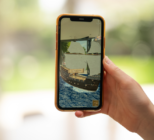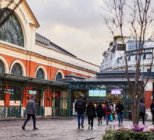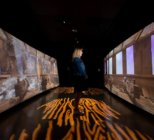So it has all been about tidying up the menus so to speak, so people get to the right choice and they leave with a much better sense of value
This project began three years ago when we began to realise that when visitors arrived they didn’t know what the offer was. They knew it was going to be brilliant, but they had a whole load of choices to make. There are 11 different attractions on site and there is a harbour bus that takes visitors to the museums.
Any one of those attractions is a stunning attraction all by itself. But to get the most from them you have to have an itinerary, you have to work out what it is that interests you and what it is that you want to do as the visitor. Because you can’t do all 11 in a day. In reality, with dwell time, that would be at least 16 or 17 hours. Most people spend four hours at each. So, the visitor is trying to work out what they can get from their visit that gives them the most value for their time and money.
Redeveloping the website
So they face a decision, they can either buy single tickets or a ticket for everything. Where Colin Mulberg Consulting has really helped us is on redeveloping the website – they helped us understand that we needed to put the whole venue up front and explain that and then have the attractions come after it.
Before, the website was an outdated map almost that just had pictures to the venues and it didn’t tell you anything about what you got from going to each one. So now the website effectively has three layers. The website now talks about Portsmouth Historic Dockyard, then it takes visitors into the attractions, and while doing so, it talks about the benefit of the attractions and the imagery puts people into the attraction.
The big thing with all of this, is that you don’t want people to realise they are going through these layers, you want this to unfold naturally to them and for potential visitors to make commitments without realising the effort they have put into it.
Then when they go to the ticketing portal things are made simple and it is all about saying to te visitor: ‘you’re going to get the best value for your attraction ticket’.
It’s making the decisions as easy as possible so that people don’t have to spend too much time worrying about what’s on offer. They want the guarantee that they have got a great day out to look forward to. That’s what they are trying to achieve. The dockyard site is a third of a mile long, there’s a huge amount of context and if people arrive not knowing any of that it can take them an hour to get orientated to what’s actually available on site.
We started with the website and made that as easy as possible to navigate and then changed the layout of the visitor centre. It is very obvious now what all the different attractions are about with the help of graphics putting them into chronological order. This helps visitors to see what chapters there are and decide what they are interested in, for example, if they are interested in Nelson then they can easily find HMS Victory and the Nelson Gallery and buy a ticket for that. It gives you this 600-year span of history and allows you to identify that there are different chapters and you can pick and choose.
Since the beginning of the project our visitor figures have gone from 600,000 to 850,000 and revenue wise from £6m to £8m
Feedback
The driver for us was the visitor feedback we were getting was variable regarding the quality of the different attractions. We also read that some audiences were going to attractions that weren’t aimed at them. This would involve a group of older people, for example, having negative comments about Action Stations, which is aimed at a family audience. They would walk through the doors and turnaround and come straight back out.
The project then was about unpicking the offer and now with new imagery we can show different audiences experiencing the different attractions, which gives a far better indication to potential visitors. If it takes you 22 clicks to get to the information something is wrong. My message to everyone in the sector who finds themselves in a similar position to what we were in would be: ‘You spend a huge amount of effort on interpretation strategies for your story (when we design a new gallery we think about audience benefits and the collection – we put a tremendous amount of work into that) and the website is the start of that story for many, many visitors now. You need to put the same amount of effort guiding your visitors through the website as you do the stories you put forward in your gallery.’
The visitor satisfaction level for us has improved in a big way – we used to have a lot of complaints that the site was expensive and when we looked into that the conclusion we made was that people didn’t understand the offer. So, it did look expensive because they weren’t going into the right attraction for them and weren’t going into as many attractions as we thought.
So it has all been about tidying up the menus so to speak, so people get to the right choice and they leave with a much better sense of value.
Catalyst for change
People like Colin and his team are catalysts for change and you’ve really got to be open-minded and engaged with them – they will force you to do different things that might not be comfortable – and although they work in the heritage sector they are bringing skills that you are more likely to see in a commercial operation.
There is this fear of being too commercially minded in our sector. Actually what you are doing is understanding what your vistor sees and allowing your audience to understand what you do and therefore maximising your offer and the amount of money you can reinvest in conservation. Nobody should be scared of that.
This is an ongoing project and it doesn’t have an end point because the audience changes. We have to keep responding. As part of the project we have also invested in a new CRM system so that going forward we can better understand how people are using the different products.
Key Facts
Portsmouth Historic Dockyard is made up of the The National Museum, which owns and manages HMS Victory; HMS Warrior 1860; The National Museum of the Royal Navy Portsmouth; Gosport’s Royal Navy Submarine Museum and Explosion Museum of the Naval Firepower and HMS M.33.
The museum works in partnership with The Mary Rose Trust which runs the independent Mary Rose Museum and Portsmouth Naval Base Property Trust which manages Boathouse 4 and Action Stations.
Portsmouth Historic Dockyard says that the record visitor numbers of 850,000 in 2017 has an economic impact figure of £110.40 million per year.
A brand new Royal Marines Museum will open in Portsmouth Historic Dockyard in 2020 and an innovative Centre for Discovery housing two million collection items.










